In today’s digital age, where email and instant messaging dominate business communications, you might wonder if letterheads still hold any significance. The answer is a resounding yes! A well-designed letterhead not only adds a professional touch to your correspondence but also plays a crucial role in building brand recognition and establishing credibility. This comprehensive guide will walk you through everything you need to know about choosing and printing the perfect letterhead for your business.
1. Understanding the Importance of Letterheads
Letterheads are more than just decorative elements at the top of a piece of paper. They serve multiple crucial functions in business communications:
- Brand Recognition: A consistent letterhead design reinforces your brand identity with every piece of correspondence.
- Professionalism: Well-designed letterheads convey attention to detail and a commitment to quality.
- Legal Requirements: In many jurisdictions, official business communications must include specific information, often presented on letterheads.
- Marketing Tool: Letterheads can subtly market your business by showcasing your logo, tagline, and contact information.
- Trust Building: Professional letterheads can help establish credibility, especially for new or small businesses.
Understanding these functions will help you make informed decisions as we delve deeper into the process of choosing and printing the perfect letterhead.
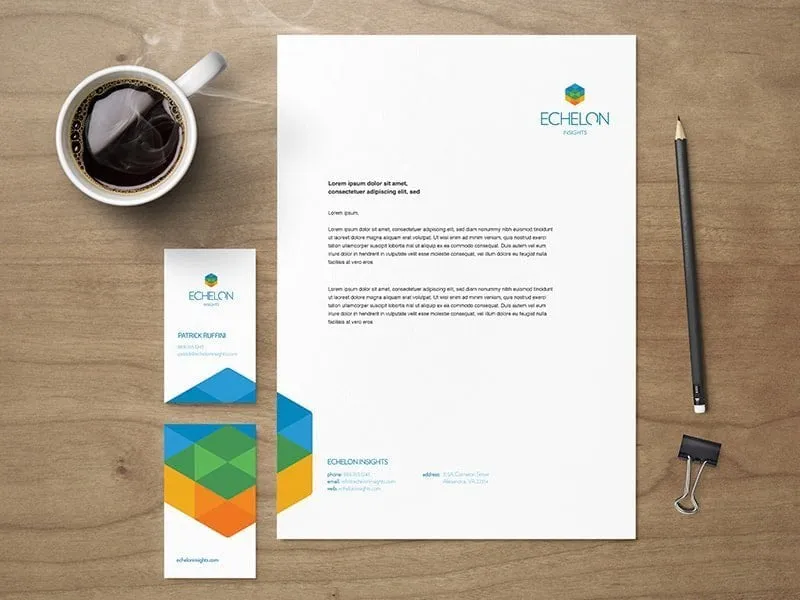
2. Key Elements of an Effective Letterhead
An effective letterhead typically includes the following elements:
- Company Logo: Your logo should be prominently displayed, usually at the top of the page.
- Company Name: If not part of the logo, your company name should be clearly visible.
- Contact Information: Include your address, phone number, email, and website.
- Legal Information: Depending on your jurisdiction, you may need to include registration numbers or other legal details.
- Design Elements: Colors, fonts, and graphical elements that align with your brand identity.
- Tagline or Slogan: If applicable, include your company’s tagline to reinforce your brand message.
- Social Media Handles: For businesses with a strong online presence, including social media information can be beneficial.
Remember, while it’s important to include all necessary information, avoid cluttering your letterhead. A clean, uncluttered design often has the most impact.
3. Choosing the Right Design for Your Brand
The design of your letterhead should be a visual representation of your brand identity. Here are some factors to consider:
- Color Scheme: Use your brand colors, but be mindful of how they’ll look when printed. Some colors may not translate well from digital to print.
- Typography: Choose fonts that are legible and consistent with your brand guidelines. Typically, you’ll want to stick to one or two fonts maximum.
- Layout: Decide whether you want a top-aligned, centered, or sidebar layout. Each has its advantages depending on your brand style and the amount of information you need to include.
- White Space: Don’t be afraid of white space. A cluttered letterhead can be off-putting and hard to read.
- Consistency: Ensure your letterhead design aligns with your other branded materials, such as business cards and brochures.
When designing your letterhead, consider working with a professional graphic designer who can help translate your brand identity into an effective letterhead design.
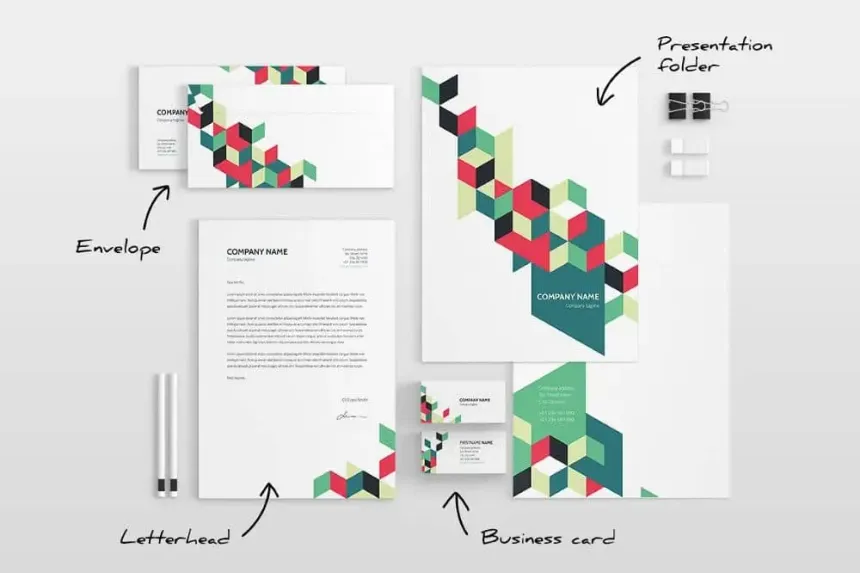
4. Selecting Appropriate Paper and Printing Methods
The paper you choose for your letterhead can significantly impact the overall impression it makes. Consider these factors:
- Paper Weight: Heavier paper (24-32 lb) is typically used for letterheads to convey quality and durability.
- Paper Finish: Options include matte, glossy, or textured finishes. Your choice should complement your design and brand image.
- Paper Color: While white is traditional, don’t be afraid to explore off-white or light colored papers if they suit your brand.
- Environmental Considerations: Consider using recycled or sustainably sourced paper to demonstrate your commitment to environmental responsibility.
As for printing methods, you have several options:
- Offset Printing: Ideal for large quantities, offering high quality and cost-effectiveness for bulk orders.
- Digital Printing: Great for smaller runs or when you need quick turnaround times.
- Letterpress: Provides a luxurious, tactile finish but is generally more expensive.
- Engraving: Offers a premium look and feel, often used for high-end or formal communications.
Your choice of printing method will depend on your budget, quantity needed, and the desired finish.
5. Legal and Professional Considerations
Depending on your location and industry, there may be legal requirements for information that must be included on your letterhead:
- Business Registration: In many countries, registered companies must include their registration number on official correspondence.
- Professional Certifications: Some industries require the inclusion of professional license numbers or certifications.
- Multiple Locations: If your business operates in multiple locations, you may need to list all addresses or clearly indicate your headquarters.
- Regulatory Compliance: Certain industries (like finance or healthcare) may have specific regulations about what information must be disclosed on official communications.
Always consult with a legal professional to ensure your letterhead complies with all relevant laws and regulations in your jurisdiction.
6. Printing Techniques and Their Impact
Different printing techniques can add unique touches to your letterhead:
- Embossing: Creates a raised effect on specific elements, adding a tactile dimension.
- Debossing: The opposite of embossing, creating an indented effect.
- Foil Stamping: Adds a metallic or colored foil to certain elements, creating a premium look.
- Spot UV: Applies a glossy coating to specific areas, creating contrast with matte elements.
- Thermography: Creates raised lettering with a slightly glossy finish.
These techniques can add visual interest and a premium feel to your letterhead, but they also increase production costs. Consider whether the added impact justifies the expense for your business.
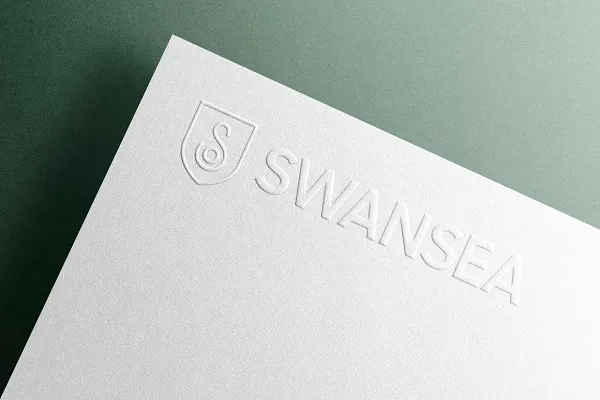
7. Digital vs. Traditional Letterheads
In today’s digital age, it’s worth considering both digital and traditional letterhead options:
Traditional Letterheads:
- Provide a tangible, professional impression
- Ideal for formal communications and legal documents
- Can be more impactful for certain audiences or industries
Digital Letterheads:
- Cost-effective and environmentally friendly
- Easy to update and distribute
- Suitable for email communications and digital document signing
Many businesses opt for a combination of both, using printed letterheads for important physical mail and digital versions for everyday email communications. Ensure consistency between your digital and physical letterheads to maintain a cohesive brand image.
8. Cost Considerations and Budgeting
The cost of letterhead production can vary widely based on several factors:
- Quantity: Larger print runs generally have a lower per-unit cost.
- Paper Quality: Premium papers will increase your costs.
- Printing Method: Specialty printing techniques like embossing or foil stamping add to the expense.
- Color Usage: Full-color printing is more expensive than one or two-color designs.
- Design Fees: If you’re working with a professional designer, factor in these costs.
To budget effectively:
- Determine your annual letterhead usage.
- Get quotes from multiple printers for different quantities.
- Consider the lifetime of your design – how often will you need to update it?
- Balance quality with cost – remember, your letterhead is an investment in your brand image.
9. Sustainability in Letterhead Production
As businesses become more environmentally conscious, sustainable letterhead production is increasingly important:
- Recycled Paper: Look for papers with high post-consumer recycled content.
- FSC Certification: Choose papers certified by the Forest Stewardship Council.
- Eco-Friendly Inks: Vegetable-based inks are more environmentally friendly than petroleum-based options.
- Local Production: Reduce transportation emissions by working with local printers.
- Digital Alternatives: Where possible, use digital letterheads to reduce paper usage.
Communicate your sustainability efforts to your customers – it can be a powerful way to reinforce your brand values.
10. Customization and Personalization Options
Customization can make your letterhead more versatile and impactful:
- Variable Data Printing: This technique allows you to personalize each letterhead with unique information, such as employee names or department details.
- Multiple Versions: Consider creating variations of your letterhead for different departments or purposes while maintaining overall brand consistency.
- Seasonal Designs: For some businesses, subtle seasonal variations in letterhead design can be effective.
- Special Editions: Create limited edition letterheads for significant company milestones or events.
Remember, while customization can be powerful, maintain consistency in your core brand elements to ensure recognition.
11. Letterhead Design Trends for 2024
Stay current with these design trends:
- Minimalism: Clean, uncluttered designs continue to dominate.
- Bold Typography: Large, statement fonts are being used to create impact.
- Geometric Patterns: Subtle background patterns add interest without overwhelming the design.
- Eco-Friendly Aesthetics: Designs that communicate sustainability, like kraft paper textures or green color schemes.
- Interactive Elements: QR codes or augmented reality features for digital integration.
- Gradients: Subtle color gradients are making a comeback in logo and letterhead design.
While it’s good to be aware of trends, prioritize timelessness in your design to ensure longevity.
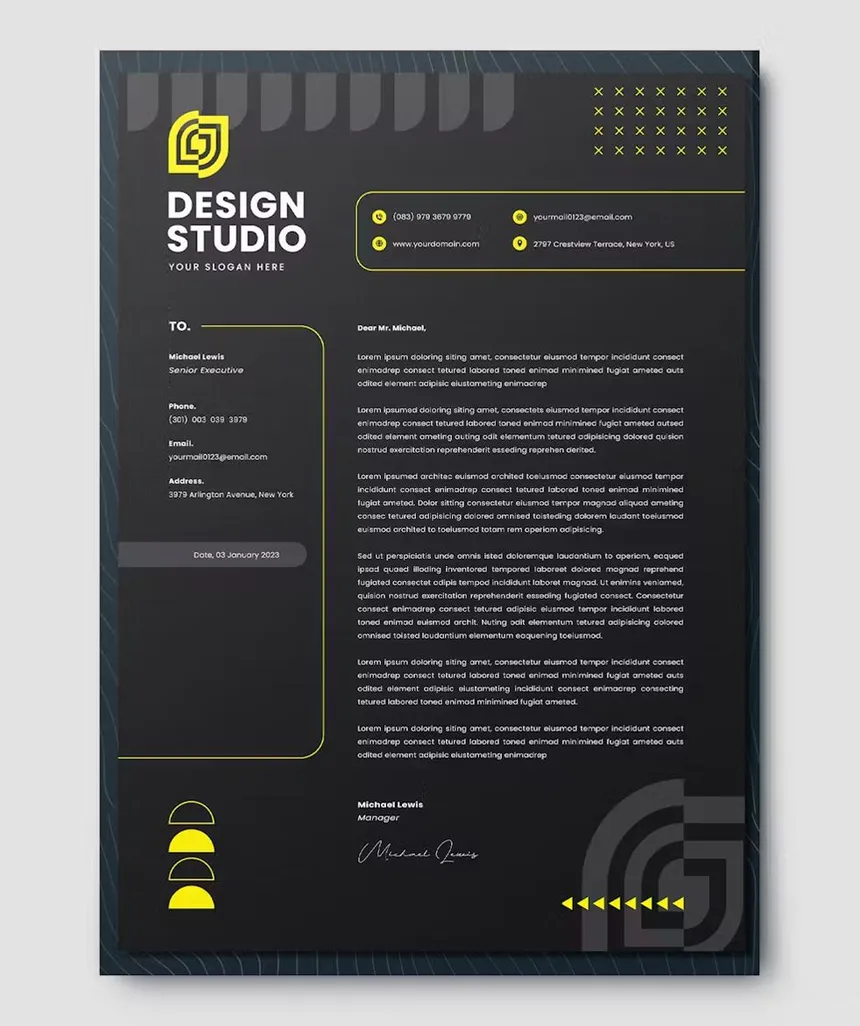
12. Common Mistakes to Avoid
Steer clear of these common letterhead mistakes:
- Overcrowding: Including too much information or design elements.
- Poor Contrast: Ensuring text is easily readable against the background.
- Inconsistency: Misalignment with other brand materials.
- Low-Quality Printing: Cutting costs on printing can result in a poor impression.
- Outdated Information: Regularly review and update your letterhead information.
- Ignoring Digital Formats: Ensure your letterhead translates well to digital formats.
- Copyright Infringement: Be careful not to use copyrighted images or fonts without permission.
By avoiding these pitfalls, you’ll ensure your letterhead effectively represents your brand.
13. Integrating Letterheads with Your Overall Brand Strategy
Your letterhead should be part of a cohesive brand strategy:
- Brand Guidelines: Develop comprehensive guidelines that cover all aspects of your visual brand, including letterhead usage.
- Cross-Media Consistency: Ensure your letterhead design aligns with your website, social media, and other marketing materials.
- Brand Story: Use your letterhead as an opportunity to subtly communicate your brand story through design elements.
- Future-Proofing: Design with flexibility in mind to accommodate potential future brand evolution.
Remember, your letterhead is often the first physical touchpoint a person has with your brand – make it count!
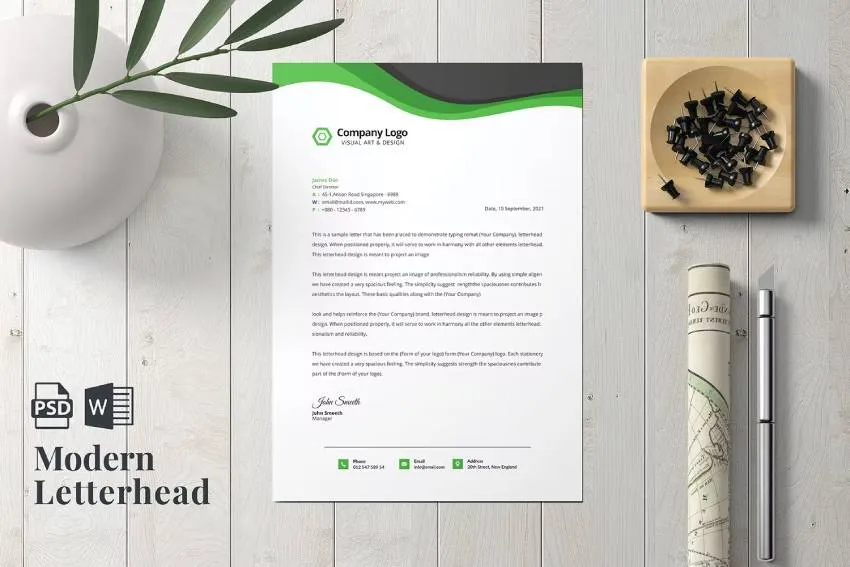
14. Measuring the Impact of Your Letterhead
While it may seem challenging to measure the direct impact of a letterhead, there are ways to gauge its effectiveness:
- Customer Feedback: Directly ask clients or partners for their impressions of your letterhead.
- Brand Recognition: Monitor improvements in brand recall after introducing a new letterhead design.
- Response Rates: For direct mail campaigns, compare response rates before and after a letterhead redesign.
- Employee Pride: Gauge how your team feels about using the letterhead – does it instill a sense of pride?
- Competitor Comparison: How does your letterhead stack up against competitors in your industry?
Use these insights to continually refine and improve your letterhead design over time.
15. Conclusion: Making Your Final Decision
Choosing the right letterhead is a balance of aesthetics, functionality, and brand alignment. As you make your final decision, consider these key points:
- Reflect on Your Brand: Does the letterhead truly represent who you are as a company?
- Consider Your Audience: Will this design resonate with your target market?
- Think Long-Term: Is this a design that will stand the test of time, or will you need to redesign soon?
- Balance Quality and Budget: Invest in quality, but ensure it aligns with your overall marketing budget.
- Get Feedback: Before finalizing, get opinions from team members, trusted clients, or a focus group.
Remember, your letterhead is more than just a piece of paper – it’s a powerful branding tool that can significantly impact how your business is perceived. Take the time to get it right, and you’ll have a letterhead that serves your business well for years to come.
By following this guide, you’re well on your way to creating a letterhead that not only looks great but also effectively communicates your brand values and professionalism. Happy designing!

